It can be very hard to find the right tennis strings for you. This problem comes from a huge array of materials and types, which are enough to overwhelm many beginners. Without knowledge, many people will just pick something and hope for the best. However, this is not a good practice at all. In this article, we will attempt to solve this problem for you and hopefully, save you some money as well. We will attempt to solve this problem by educating you about the unique qualities of each string type.
How to choose the best tennis racquet strings?
The purpose of this article is not to recommend a specific product for you, but instead to give you some knowledge with which to evaluate for yourself. We hope that this short guide can help you to achieve that perfect game that every player truly wants. Rather than focus on specific products, we will talk about various features that are important as you choose the best tennis racket strings for you. These features will include:
- Tension
- Durability
- Gauge (thickness)
- Material
- Construction
- Spin, power, and control
Tension
When you attempt to choose the best tennis racket strings, you are almost invariably making a choice between power and control. While stiffer strings provide superior control, they also lose a little of their power due to their lack of spring. It really comes down to your style.
All tennis rackets have a recommended range of string tension, and that range is usually in the neighborhood of 50-70 pounds. Likewise, all string types are rated for a certain range of tennis racket string tension. It is very important not to go beyond this range, or below it.
If you are a beginner, it is usually advisable to seek a “middle ground” option that balances power and control with a medium level of racket string tension. However, more advanced players usually find that they prefer high tension or low tension. Apart from the obvious differences in power and control, there is also a difference in the size of the “sweet spot.” When your strings are at a lower tension, that sweet spot in the middle is enlarged, making it possible to get a solid hit even if you are a little off-center. With a high-tension setup, you really have to hit that ball dead-center.
Durability
One would think that an obvious choice in this department would be to buy the most durable strings you can find. This is, however, not true. More durable strings are stiffer, and thus better able to stand up to the many whackings that they must give. However, this increased stiffness results in decreased power (as explained above), as well as a different feel. Some players feel that they just cannot get the same results from stiffer strings. Does this mean that they will be breaking strings more often? Probably so. Then again, it also depends on their style and how hard they prefer to hit their ball. A durable high-tension string will also transmit more force to both the racket and your arm, which makes for a much greater chance of tennis elbow. However, power players who really like to spike that ball as hard as possible often find a more durable string to be a must. The best durable tennis string is one that fits your style of play.
Gauge
String gauge is a measure of thickness. Naturally, thicker strings are sure to be more durable and hold up to harder use. However, as you can probably guess, there are trade-offs as well as other factors. There is a definite difference in power, as thicker strings deliver a harder hit than their slimmer counterparts. On the other hand, slimmer strings give a much better spin factor and a different feel, and that makes them superior for certain styles of play.
Tennis string gauges generally range from 15 to 19, with 15 being largest and 19 being smallest. Note that the numbers progress backward from thinner to thicker. This translates in millimeters to a thickness of between 1.49 (for a 15-gauge tennis string) and 1.22 (for an 18 gauge tennis string). It may seem like a small difference, but those fractions of a millimeter can change your entire game.
Materials
Natural:
You may have heard that old myth that tennis rackets were once strung with catgut. While the name “catgut” has been used for these kinds of materials, cats were never used as a source. Natural gut strings are made from the intestinal walls of various animals and were the only choice available for many years. With their superior springiness and control, they are still considered by many to be a superior choice. However, they are also the most expensive strings around. Prince natural gut strings are the most popular brand for this type of string.
Synthetic:
This is a term that includes pretty much everything other than natural gut. Since these strings are made of substances that are much easier to produce, they are also much cheaper to purchase. These can be made of nylon, polyester, or kevlar. They can be made as a monofilament or multifilament string, meaning that they can be extruded as a single piece or spliced together from multiple pieces.
Polyester (poly):
Polyester makes for some of the most durable and stiff kind of string. These are very popular with pro players because they can stand up to serious abuse. If your style is heavy on spin and light on accuracy, these are probably the best synthetic gut strings for you. The best polyester tennis string is likely to be the thickest one you can find, to take maximum advantage of its unique properties.
Nylon:
Nylon strings, also known as nylon gut, is the most popular type of string with new players because it does a good job of balancing power with control. Although it is quite a bit stiffer than natural gut, it still has a soft springiness that appeals greatly to those with a little less precision. With good nylon strings, you get the durability and control of stiffer strings in a form that is easier to use. Nylon strings are nearly all multi-filament strings, though this is not an absolute rule.
Kevlar:
This is what you might call an extreme durability option. If you really want something that is hardcore, kevlar tennis strings are a good choice for you. If it can stop a bullet, it can stop nearly anything, so you can bet that your kevlar strings won’t have to be replaced very often. However, it also carries maximum risk of tennis elbow.
Hybrids:
These strings are combinations of materials and are thus difficult to discuss. No two will be alike, which is the point of hybridization. The best hybrid tennis strings are those that offer the benefits of multiple string types while minimizing their negatives.
Construction
Monofilaments:
These strings are made by extrusion and are made of a single material. Their simple, solid construction makes them very durable, but a lot stiffer as a consequence. Monofilament tennis string is very much recommended for those who break their strings frequently. These are most often made of either polyester or kevlar, though they are often found in hybrid strings as well. These strings will normally be inferior in terms of power and comfort.
Multifilaments:
Multifilament tennis string comes in many different forms, but all of them share a composite construction in which multiple strands are twisted together. These are really good for comfort and power but tend to suffer from durability problems. Much like a spliced cable, even the best multifilament tennis string will never be as strong as a solid piece. If you prefer a high level of tension, these strings are not for you. In comparing multifilament vs. poly, it is hard to choose because both have their unique advantages.
Spin, Power, and Control
Spin:
Not everyone chooses to utilize spin. For those who do, it is highly recommended to stay away from thicker gauge strings. These are inferior for generation of proper spin. Slim strings will help you to get a lot more spin, and are thus the best tennis strings for spin. Polyester is a preferred material for players who emphasize this technique.
Power:
Springiness is everything when you want power. The best tennis strings for power are those that offer maximum flexibility and which are suited for low string tension. By absorbing the force of a ball’s impact and reversing it, more energy is transferred to the ball. However, string thickness will also play a role.
Control:
As in any competitive endeavor, accuracy can count for just as much as power. Stiffer strings with more tension will nearly always give superior control and accuracy, allowing you to make those pinpoint shots that confound your opponent’s ability to stop them. The best tennis strings for control will require a player to be more accurate, hence why they are not popular among amateur players.
| Durability | Gauge | Materials | Construction | Spin, Power, and Control | |
| Luxilion ALU Power 125 | Very High | 16 L | Poly-Ether-Ether | Extruded Monofilament | High, Very Low, Very High |
| Babolat RPM Blast | Very High | 16 | Co-Polyester | Extruded Monofilament | Very High, High, Medium |
| Wilson NXT Control | Medium | 16 | Polyester and Polyamide | Multifilament | High, Medium, High |
| RPM Blast Back | Very High | 17 | Co-Polyester | Extruded Monofilament | Very High, High, Medium |
| Wilsons Champions Choice Duo | High | 16 | Natural Gut and Co-Polymer | Multifilament | High, High, High |
Top 5 Tennis String Reviews
At some point, your racket will need to be restrung. That will present you with a perfect opportunity to upgrade your play. Customers will often shop for products based on the material they are made from or the features designed into them.
Each equipment review listed below provides you with key features, along with the good and not so good of that product’s design process so you can improve play.
Luxilion ALU Power 125 – best tennis strings 2019
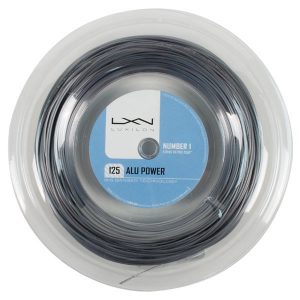 This product is used by the majority of top 100 players.
This product is used by the majority of top 100 players.
Manufactured by Wilson, a world leader in sports equipment.
A good selection for serious players. Can assist with advanced ball control.
Key Features
Durability: Its poly-line is designed to last.
Gauge: Comes in 16-gauge.
Materials: Made from robust poly-ether.
Construction: Extruded as a single string.
Spin, Power, and Control: Great control and spin, but lacks power.
Pros
- Provides incredible control
- Not affected by weather
- Plays consistently
- Best luxilon string design
Cons
- Doesn’t help much with power
- Extremely firm when strung
- Isn’t begginer friendly
Verdict: Increased control and power make these the top tennis string product for serious players.
https://www.amazon.com/dp/B0015FMU1G
Babolat RPM Blast – best tennis strings for spin
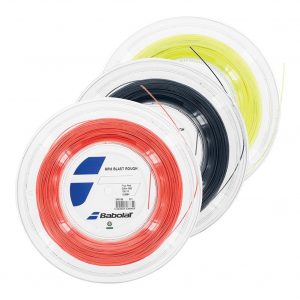 The RPM Blast is all about the spin.
The RPM Blast is all about the spin.
Babolat is a French company that is known for their strings.
Intermediate players with long swings may enjoy these. Fast players will also benefit.
Key Features
Durability: This monofilament tennis string is substantial.
Gauge: Constructed in 16-gauge.
Materials: Made from Co-Polyester thermoplastics.
Construction: Extruded as a single piece.
Spin, Power, and Control: High levels of power and spin, although it is average in control.
Pros
- Generates lots of ball spin
- They spring back quickly
- Control through backhand
Cons
- May generate some tension loss
- Plays stiff for novices
- Limited improvement for slower players
Verdict: Heavy racket players with big swings may see these as the best tennis strings for spin and power.
https://www.amazon.com/dp/B00COFUREI
Wilson NXT Control – best multifilament tennis string
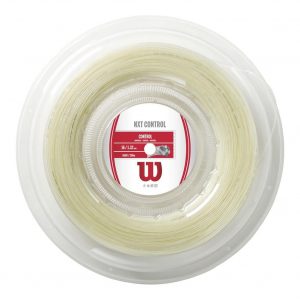 NXT should provide you with improved control.
NXT should provide you with improved control.
For decades, Wilson has designed sporting equipment to improve a player’s game.
These would be good strings for average players. They will benefit from the increased control.
Key Features
Durability: They’re average in longevity.
Gauge: Designed in 16-gauge.
Materials: Its fibers are Polyester and Polyamide.
Construction: These are multifilament tennis strings.
Spin, Power, and Control: They provide good control and spin while generating decent power.
Pros
- Can notice increased control
- Crisp feel for multifilament
- Provides decent playable longevity
- Feels comfortable through swing
Cons
- They will begin to fray
- Poly fibers should generate even more spin
- May feel loose to some users
Verdict: This could be the best tennis strings for spin and control for casual play.
https://www.amazon.com/dp/B00GKQGKVQ
RPM Blast Black – best tennis strings for juniors
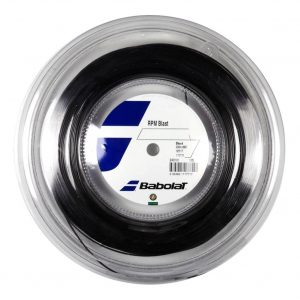 The durability of the RPM 17s makes them forgiving for developing players.
The durability of the RPM 17s makes them forgiving for developing players.
Babolat is a well-established European brand known for their quality racket strings.
Users developing speed and power will benefit from these. Novices will also admire increased ball spin.
Key Features
Durability: They’re extremely durable tennis strings.
Gauge: Built as 17-gauge.
Materials: Made from co-polyester plastics.
Construction: It is produced in a single piece.
Spin, Power, and Control: While these produce average control gains, they do increase power and spin.
Pros
- Strings move back into place fast
- Surface increases power at ball contact
- They produce great spin
- four
Cons
- Beginners will notice stiffness
- Generates less gains with slow swings
- They don’t hold tension well
Verdict: An increase in power and ball spin make these the best tennis strings for beginners.
https://www.amazon.com/dp/B00BOEN288
Wilson Champions Choice Duo – best tennis strings for intermediate player
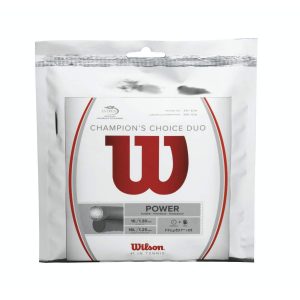 These might be the best hybrid strings for spin and power without sacrificing control.
These might be the best hybrid strings for spin and power without sacrificing control.
Wilson’s labs have been improving racket-related products for years.
Mid-range players will enjoy the increased play offered here. Provides increases to adequate play without generating downsides.
Key Features
Durability: These are generously strong.
Gauge: Engineered as 16-gauge.
Materials: A blend of natural gut and co-polymer
Construction: Produced with multiple filaments.
Spin, Power, and Control: Provides generous increases in power and spin while offering good control.
Pros
- Aluminum and resin increases strength
- Increased control on the ball
- Power boost for weaker swings
Cons
- Depth control at the net
- Can generate too much power for some
- They’re higher priced
Verdict: Their improved play without noticeable drops in quality make them the best hybrid tennis string combinations for intermediate play.
https://www.amazon.com/dp/B00GKQGUXE
Top Questions From Customers About Tennis Strings
No matter what your skill level is, you might have some general questions about product design or use. We have taken a couple of the top questions asked by players and provided some answers.
Matching this type of equipment to your skill level is critical for generating improvements on the court without creating handicaps with your strings. With all of the information out there it can be difficult to find answers. We hope to help with that.
What is the best multifilament tennis string?
Multifilament tennis strings are made from microfibers that have been weaved together. While cheaply made items may consist of hundreds of these fibers, the best multifilament strings are made of thousands of these tiny strands. In its final form, this design is intended to replicate many of the characteristics found in natural gut strings.
One benefit that they offer is a level of comfort during play. All users will enjoy this, but it can become a necessity for those suffering from injuries like tennis elbow.
Multifilament strings also provide you with greater playability on your racket. Manufacturers create various shapes and tension levels to influence contact with the ball. These design elements can increase your control, spin, or power.
How often should you restring your tennis racquet?
Everyone will need to replace even the most durable tennis string. The truth is that this component of your gear begins to wear out once your racket is restrung. Even the best products can lose a percentage of their tension within 24-hours of being installed.
A general rule that many go by is: You should contemplate restringing your gear as many times throughout the year as you find yourself playing each week. For example, if you play twice a week you might consider restringing your racket twice during the year.
Of course, other factors need to be considered. Your playing style, session lengths, and even your budget can influence the lifespan of products strung to your tennis racket.
Now You Can Strung The Best Tennis Strings
Even though all of the products reviewed offer you beneficial features, we feel that the Luxilion ALU Power 125are the best tennis strings available. Created in Wilson’s laboratories, this gear offers features that the world’s top-rated players enjoy.
This poly-line filament is rugged and will last. Being extruded in one piece means it’s resistant to fraying. The 16-gauge material won’t be affected by weather, keeping it consistent.
ALU Power 125 produces great control while also generating additional spin on the ball. Increased power is slight for most users.
- Babolat RPM Blast – Suggested for powerful hitters looking for spin.
- Wilson NXT Control – Recommended as one of the better multifilament products for casual playing.
- RPM Blast Back – A good recommendation for juniors developing their control.
- Wilsons Champions Choice Duo – Recommended for intermediate players looking for improvement without sacrificing anything.